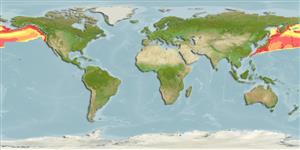>
Argentiniformes (Marine smelts) >
Bathylagidae (Deep-sea smelts)
Etymology: schmidti: Named after P.J. Schmidt, USSR ichthyologist (Ref. 6885).
Eponymy: Dr Petr Yulievich (Julievich) Schmidt (1872–1949) was a Soviet Russian ichthyologist who described a great many fish taxa. [...] (Ref. 128868), visit book page.
Environment: milieu / climate zone / depth range / distribution range
Écologie
marin bathypélagique; profondeur 394 - 1800 m (Ref. 6793). Deep-water; 61°N -
North Pacific: southeastern Hokkaido, Japan to Navarin Canyon in the Bering Sea and southern British Columbia, Canada. Possibly in Kamchatka (Ref. 6885). Regarded as a subspecies of Leuroglossus stilbius, Gilbert 1890 but Peden (1981) presented evidence for separating the two and Dunn (1983) placed them in the genus Leuroglossus.
Taille / Poids / Âge
Maturity: Lm ? range ? - ? cm
Max length : 20.0 cm SL mâle / non sexé; (Ref. 96339)
Description synthétique
Clés d'identification | Morphologie | Morphométrie
Épines dorsales (Total) : 0; Rayons mous dorsaux (Total) : 10 - 11; Épines anales: 0; Rayons mous anaux: 11 - 14; Vertèbres: 47 - 52. Body slender and compressed. Anal fin base short, and almost equal to dorsal fin base. snout pointed. Eye diameter shorter than snout length. Upper jaw shorter than lower jaw. Teeth present on lower jaw, prevomer, palatine, but not on upper jaw. Branchiostegals, 2. Color silvery, dusky on dorsal surface and fins (Ref. 6885).
Adults are generally found at depths greater than 150 m during the day. Oviparous, with planktonic eggs and larvae (Ref. 35604), which are distributed in the sub-arctic gyre south to about 47°N (Ref. 6848).
Life cycle and mating behavior
Maturité | Reproduction | Frai | Œufs | Fécondité | Larves
Allen, M.J. and G.B. Smith, 1988. Atlas and zoogeography of common fishes in the Bering Sea and northeastern Pacific. NOAA Tech. Rep. NMFS 66, 151 p. (Ref. 6793)
Statut dans la liste rouge de l'IUCN (Ref. 130435: Version 2024-1)
Menace pour l'homme
Harmless
Utilisations par l'homme
Pêcheries: sans intérêt
Outils
Articles particuliers
Télécharger en XML
Sources Internet
Estimates based on models
Preferred temperature (Ref.
123201): 2 - 4.7, mean 3.1 °C (based on 151 cells).
Phylogenetic diversity index (Ref.
82804): PD
50 = 0.6250 [Uniqueness, from 0.5 = low to 2.0 = high].
Bayesian length-weight: a=0.00617 (0.00319 - 0.01192), b=2.96 (2.79 - 3.13), in cm total length, based on LWR estimates for this species & (Sub)family-body (Ref.
93245).
Niveau trophique (Ref.
69278): 3.1 ±0.0 se; based on diet studies.
Résilience (Ref.
120179): Milieu, temps minimum de doublement de population : 1,4 à 4,4 années (Preliminary K or Fecundity.).
Fishing Vulnerability (Ref.
59153): Low vulnerability (14 of 100).
